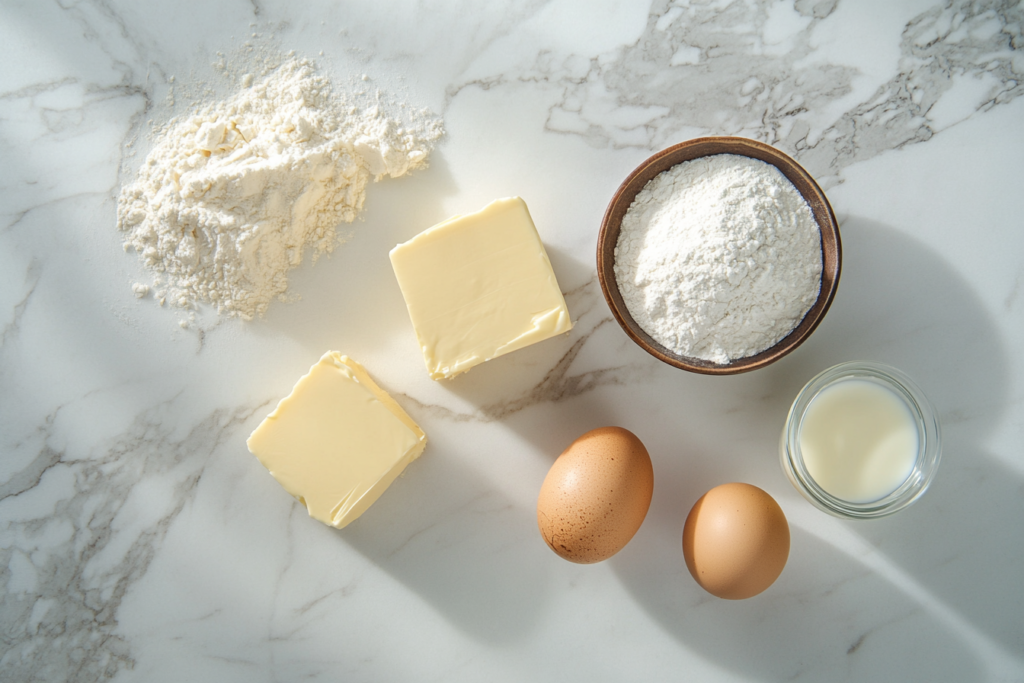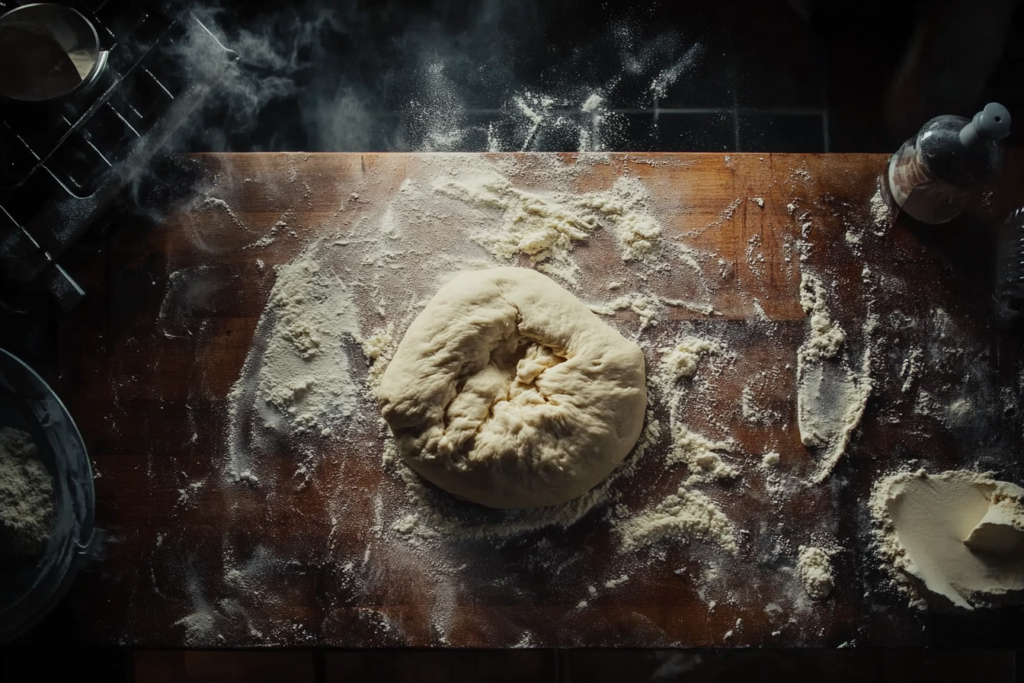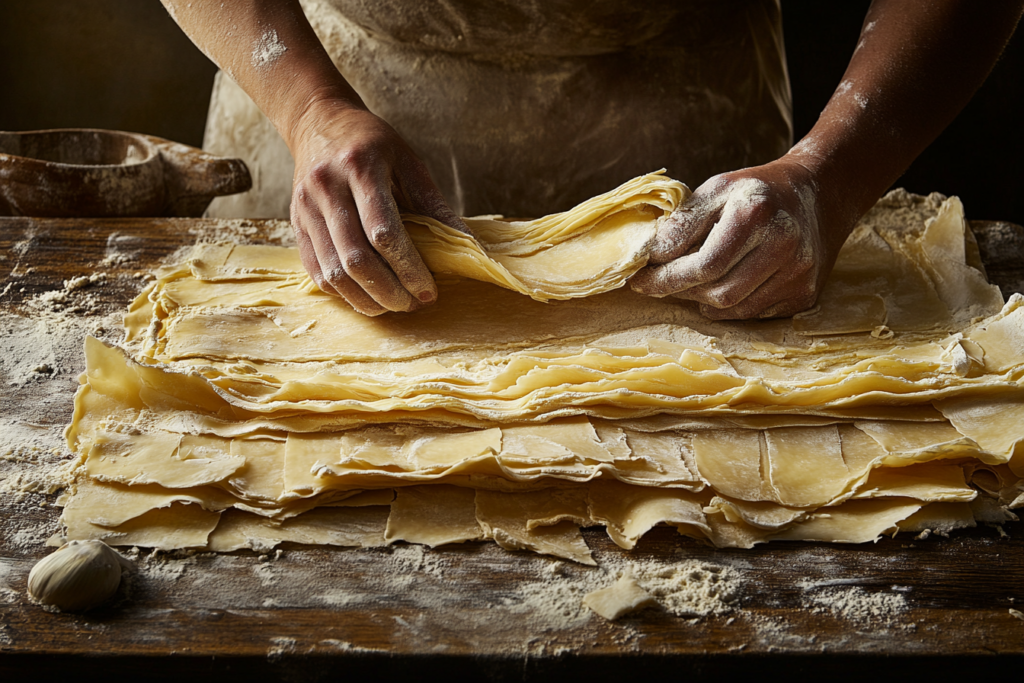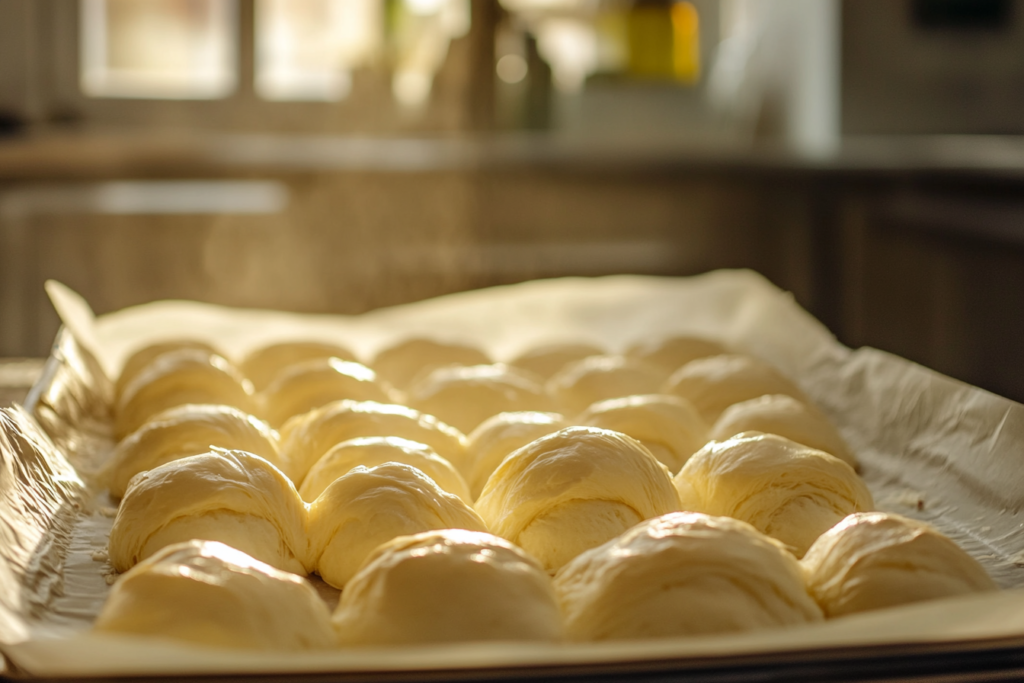Introduction: The Art of Croissant Making
What is a common mistake in croissants? Making these delicate pastries isn’t just baking—it’s an art form. Achieving that perfect flaky, buttery texture starts with understanding the basics and avoiding common pitfalls. From using the right tools to mastering techniques, knowing what to do—and what not to do—makes all the difference.
In this guide, we’ll explore what is a common mistake in croissants and how to fix it. Whether it’s incorrect butter temperature, uneven layering, or underproofing, these missteps can affect your croissants’ texture and flavor. Let’s dive into the essentials and uncover the secrets to making perfect croissants every time.
History of Croissants
Croissants trace their history back to the Austrian kipferl, a crescent-shaped bread that dates to the 13th century. It wasn’t until the 17th century that the recipe traveled to France, where bakers added layers of butter and transformed it into the croissant we know today. The French word “croissant” means crescent, reflecting the pastry’s shape.
Ingredients: Choosing the Right Quality

Great croissants start with great ingredients. The key players? Flour, butter, yeast, sugar, milk, and a pinch of salt. But here’s the thing: not just any ingredients will do. High-quality butter with a high fat content (preferably European-style butter) is non-negotiable. Why? Because the butter is responsible for those lovely layers, and skipping this detail can lead to common croissant problems.
Similarly, using strong flour with a high protein content helps form the structure of the dough. Sugar and milk add a touch of sweetness, while yeast brings the dough to life. Salt, although minimal, is essential to balance the flavors.
Traditional vs. Modern Methods
Traditionally, croissant dough was rolled and folded by hand—a painstaking process that could take hours, if not days. Modern methods, however, incorporate machines to streamline the lamination process, making it easier to produce croissants on a larger scale. Still, many bakers prefer the traditional approach, believing it results in a more authentic flavor and texture.
What is a common mistake in croissants
Let’s face it, croissant-making can feel like walking a tightrope. A slight misstep, and you could end up wondering, what is a common mistake in croissants? Dense, greasy pastries instead of light, flaky masterpieces are often the result of errors in technique or preparation. Here are some of the most common mistakes in croissant-making and how to avoid them, ensuring you achieve those buttery layers every time. By mastering these tips, you’ll never need to ask again, “what is a common mistake in croissants?”
Overmixing the Dough

One of the most frequent culprits behind failed croissants is overmixing the dough. When you knead the dough too much, you develop too much gluten, resulting in a tough texture. The goal is to mix just enough to bring the ingredients together.
Incorrect Butter Temperature
Butter temperature can make or break your croissants. Too cold, and it will crack during rolling. Too warm, and it will seep into the dough, ruining those delicate layers. The sweet spot? Cool but pliable butter that rolls out smoothly.
Uneven Layering Techniques
Even layering is essential for that signature flakiness. If your layers are uneven, some parts of the croissant will puff up beautifully while others remain flat. The trick is to roll out the dough evenly and fold it with precision.
Nutrition Facts
Here’s a quick overview of the nutritional breakdown of an average croissant:
| Nutrient | Per Serving (1 Croissant) |
|---|---|
| Calories | 231 kcal |
| Total Fat | 12 g |
| Saturated Fat | 7 g |
| Cholesterol | 33 mg |
| Sodium | 250 mg |
| Total Carbohydrates | 25 g |
| Dietary Fiber | 1 g |
| Sugars | 4 g |
| Protein | 5 g |
Key Techniques for Perfect Croissants
Making perfect croissants at home may seem intimidating, but it’s all about mastering the right techniques. By avoiding common croissant problems, such as uneven layering or incorrect butter temperature, you’ll be on your way to creating bakery-quality pastries that will impress everyone.
Similarly, using strong flour with a high protein content helps form the structure of the dough. Sugar and milk add a touch of sweetness, while yeast brings the dough to life. Salt, although minimal, is essential to balance the flavors and avoid croissant mistakes that could compromise the taste.
Importance of Lamination

Lamination creates the croissant’s signature flaky layers. It involves layering butter into the dough and folding it multiple times while keeping everything cool. Warm butter blends into the dough, ruining the layers.
Roll the dough into a rectangle, place butter in the center, and fold it like an envelope. Chill between folds to keep the butter firm. Repeat this process 2-3 more times to build delicate layers. Patience is key for perfect results.
Timing and Resting Dough Properly
Resting allows the gluten to relax and the yeast to develop, creating a better texture and flavor. After each fold, chill the dough for at least 30 minutes to keep the butter firm and layers intact.
Skipping this step can lead to dense croissants. Proper resting ensures light, flaky pastries every time.
Ideal Baking Temperatures
Croissants bake best at 375°F–400°F (190°C–200°C). The high heat steams the butter quickly, creating airy layers and a golden crust.
Keep a close eye while baking, as croissants can overbake fast. Look for a golden exterior with a hollow, airy interior for the perfect bite.
Baking Process Pitfalls
Even with all your preparation, things can still go sideways during the baking process. One of the most common croissant mistakes is uneven baking, often caused by inconsistent oven temperatures or improper dough proofing. Here are some common pitfalls to watch out for and how to troubleshoot them effectively.
Underbaking or Overbaking
Have you ever pulled your croissants out of the oven only to find they’re raw in the middle? That’s a classic sign of underbaking. On the flip side, overbaking can dry them out, robbing them of their buttery goodness. To strike the perfect balance, follow the recipe’s baking time closely and check for that golden-brown color.
Inconsistent Oven Temperature
Not all ovens are created equal. Some have hot spots that can cause uneven baking. If you notice that one side of your croissants is browning faster than the other, it might be time to rotate your baking sheet halfway through. An oven thermometer can also help you monitor and maintain the correct temperature.
Misjudging Color and Texture
It’s easy to rely on color as your only indicator of doneness, but texture is just as important. A perfectly baked croissant should feel light and hollow when tapped on the bottom. If it feels dense, it might need a few extra minutes in the oven.
Errors in Ingredient Ratios
Croissants are a delicate balance of ingredients, and even small missteps can lead to big problems. What is a common mistake in croissants? Let’s break down some common issues with ingredient ratios and how to fix them.
Too Much Flour
Adding too much flour can make the dough stiff and hard to roll out. While it might be tempting to add extra flour to prevent sticking, use it sparingly. A lightly floured surface is all you need to keep the dough manageable without compromising its texture.
Insufficient Yeast
Yeast is the powerhouse behind the dough’s rise, so using too little can result in flat, dense croissants. Always measure your yeast carefully, and make sure it’s fresh. If your yeast has been sitting in the pantry for months, it might be time for a replacement.
Skipping Salt for Flavor Balance
Salt might seem like a minor ingredient, but it plays a major role in balancing the flavors. Skipping it can leave your croissants tasting bland, no matter how much butter you use. Stick to the recipe, and don’t skimp on the salt—it’s the unsung hero of baking.
Role of Butter in Croissants
If there’s one ingredient that defines a croissant, it’s butter. But not just any butter will do. Understanding how to choose and handle butter can make all the difference.
Why Butter is Critical
Butter is the key to those luscious, flaky layers that make croissants so irresistible. Its high-fat content creates steam during baking, which separates the layers of dough and forms that airy texture. Without butter, you’d end up with something more like bread than a croissant.
Choosing the Right Butter Type
Not all butter is created equal. For the best results, opt for European-style butter with a fat content of at least 82%. This type of butter is richer and creamier than regular butter, making it ideal for laminating dough. Unsalted butter is also preferred, as it gives you more control over the flavor.
Managing Butter Consistency
Consistency is everything when it comes to butter. It should be cool but pliable—cold enough to hold its shape but soft enough to spread easily. To achieve this, give your butter a few quick taps with a rolling pin before folding it into the dough. This helps soften it evenly without melting.
Shaping Challenges
So, you’ve laminated the dough and perfected the layers—now comes the fun part: shaping your croissants. But don’t be fooled; even this stage has its fair share of challenges. Shaping errors are a common croissant problem that can affect the final texture and look of your pastries. Let’s dive into the common issues and how to overcome them.allenges. Let’s dive into the common issues and how to overcome them.
Proper Croissant Folding
Shaping croissants combines creativity and precision. Roll the dough into a large rectangle about 1/8 inch thick. Cut it into triangles, typically 4 inches wide at the base and 8 inches long. Stretch the base slightly, roll it tightly toward the tip, and curve the ends for the classic crescent shape. Avoid rolling too tightly to preserve the delicate layers.
Achieving Uniformity in Shape
Consistent shapes not only look professional but also bake evenly. Measure and cut your triangles carefully to ensure they puff up at the same rate. Taking the time to measure saves you from uneven results later.
Sealing Edges to Prevent Leaks
Butter leakage during baking is a common issue caused by poorly sealed edges. Press the seams firmly as you roll the croissants to lock the butter inside. Chilling the shaped croissants before baking also helps solidify the butter, reducing the chances of leaks.
Proofing Problems
Proofing is a critical step that determines the lightness and fluffiness of your croissants. Get it wrong, and your pastries could end up flat or overly dense. One of the most common croissant problems is underproofing, which prevents the dough from rising properly and developing its signature airy texture. Let’s address some common proofing pitfalls.

Overproofing vs. Underproofing
Proofing is a bit like a Goldilocks situation—it needs to be just right. Overproofed croissants will lose their structure and collapse in the oven, while underproofed ones won’t rise enough, resulting in a dense texture. The ideal proofing time depends on your kitchen temperature but usually ranges from 1.5 to 2 hours. Look for croissants that are slightly puffy and jiggle when you move the tray.
Ideal Proofing Environment
Croissants thrive in a warm, humid environment during proofing. If your kitchen is too cold, the yeast will struggle to activate. On the other hand, if it’s too hot, the butter might melt, ruining the layers. A proofing box or an oven with the light turned on can create the perfect environment. Place a bowl of warm water nearby to add humidity.
Proofing Time for Best Results
Patience is key when proofing croissants. Rushing this step can lead to uneven results. A good rule of thumb is to let them proof until they’ve nearly doubled in size. If you’re unsure, gently press the dough with your finger—it should leave an impression that slowly springs back.
Avoiding Burnout in Baking
Let’s be real: croissant-making is a labor of love. Between the laminating, folding, proofing, and baking, it’s easy to feel overwhelmed. But don’t worry—baking should be a joyful experience, not a source of stress.
Tips for Beginners
If you’re new to croissant-making, start small. Don’t aim for perfection on your first try. Instead, focus on learning the process and having fun along the way. Remember, even professional bakers didn’t master croissants overnight.
Importance of Patience and Practice
Croissant-making is as much about the journey as it is the result. Every batch you make teaches you something new, whether it’s how to handle the dough better or how to perfect your folding technique. Embrace the learning curve and celebrate your progress.
Embracing Mistakes as Learning
Mistakes are inevitable, but they’re also invaluable. Did your butter leak out? Did the layers not puff up as much as you’d hoped? Don’t let it discourage you. Take notes on what went wrong, and use that knowledge to improve your next attempt. After all, every croissant, perfect or not, is a delicious success.
Taste and Texture Issues
When you finally take that first bite of a homemade croissant, you want it to be everything you dreamed of—light, flaky, and buttery. If something feels off, here’s how to troubleshoot common taste and texture problems.
Achieving the Perfect Flaky Texture
Flakiness comes down to the layers, and the layers depend on your lamination technique. If your croissants feel more like bread than pastry, it’s likely that the butter melted into the dough during folding. To fix this, keep everything cool at all times and avoid overworking the dough.
Preventing Doughy Centers
A croissant with a doughy center can be disappointing. This issue is usually caused by underbaking or uneven shaping. Make sure your croissants are proofed properly, and bake them until the bottoms feel firm and hollow when tapped.
Enhancing the Buttery Flavor
Sometimes, croissants just don’t taste buttery enough. The solution? Use high-quality butter with a rich flavor. Additionally, avoid using too much flour during rolling, as it can dilute the buttery taste.
When making croissants, precision and technique are key to avoiding common pitfalls. For instance, maintaining the correct butter temperature during lamination is crucial to achieving those delicate layers. If you’re curious about similar flaky pastries, you might enjoy the Gipfeli Recipe: A Step-by-Step Swiss Pastry Guide, which highlights another buttery, layered pastry. Additionally, understanding the importance of resting and proofing dough can make or break your croissants. For a more detailed look at achieving perfection in baked goods, check out Baked Scrambled Eggs for Sandwiches, which discusses creating structure and texture in a simple dish. Lastly, ensuring even layering techniques is vital for consistent puffiness and flakiness—something equally celebrated in recipes like Baked Potato with Scrambled Eggs, showcasing the beauty of balanced textures in baking.
Conclusion
Mastering the art of croissant-making is no small feat, but it’s a journey worth taking. With patience, practice, and the right techniques, you’ll soon understand what is a common mistake in croissants and how to avoid it. From overmixing the dough to incorrect proofing, knowing what is a common mistake in croissants will help you perfect every batch. Whether you’re making croissants for your family, friends, or just yourself (because let’s be honest, you deserve it!), each flaky, buttery bite is a reward for your hard work. So roll up your sleeves, preheat your oven, and let the magic of baking begin. Happy croissant-making!
FAQs Related to What Is a Common Mistake in Croissants
What is a mistake when making croissants?
A common mistake is letting the butter warm up during lamination. Warm butter blends into the dough, ruining the flaky layers. Keeping the dough and butter cool throughout the process is essential for success.
What makes a bad croissant?
A bad croissant is dense, greasy, or lacks layers. This often happens due to improper lamination, overmixing the dough, or skipping critical resting periods. Baking at the wrong temperature can also result in an uneven texture or burnt exterior.
What is the secret to a good croissant?
The secret lies in precise lamination, high-quality butter, and proper resting times. Consistently cold ingredients, evenly rolled layers, and careful proofing ensure a flaky texture and buttery flavor. Patience is key to mastering the process.
How do you know if a croissant is underproofed?
An underproofed croissant will feel dense and won’t puff up properly in the oven. Look for croissants that are slightly puffy and jiggle when moved before baking. If they lack these signs, they may need more proofing time.

